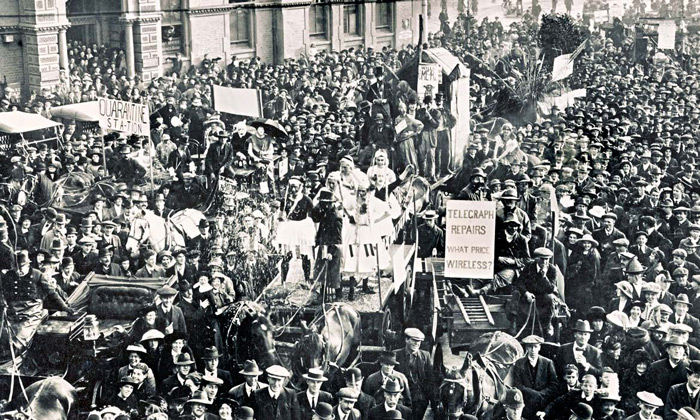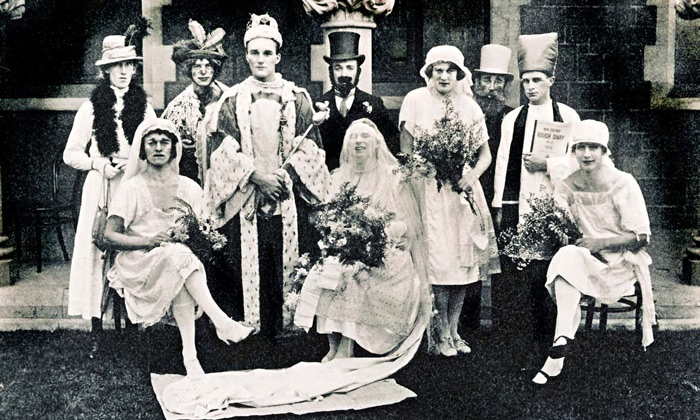Procesh entering Cathedral Square watched by a crowd of thousands, c.1920.

Charities Day and Procesh
Graduation ceremonies were formal and allowed for limited numbers of guests. Procession (or Procesh) and Charities Days by contrast, took the celebration out onto the streets of Christchurch. The first Procesh took place in 1899 when students took to the streets styled as the College Nondescript Brigade, clad in caps and gowns, and riding in a hansom cab. By 1908 the procession consisted of 4 tableaux, one of which parodied suffragettes, and another was a replica of the ‘old tin shed’ complete with evil smelling smoke. From these small beginnings, Procesh grew into a large street parade with floats and performers, which was often seen by large crowds.
By 1928 Procesh was so large that the Students' Association took formal control and appointed a procession controller. Planning for Procesh began months in advance, necessary as the event had to be approved by the City Council, which stipulated that floats not be ‘suggestive’. Floats were constructed on borrowed lorries, often not available until the morning of the procession, and students then had to be off the streets by noon. It was estimated that the 1928 Procesh was watch by a crowd of several thousand onlookers, and included speeches by the 'Studens Rex' from the balcony of Warners, and an exhibition in Cathedral Square of football by the ‘All Blacks’ who won 17 nil – against whom is not recorded.

Procesh entering Cathedral Square watched by a crowd of thousands, c.1920.
While there were occasional complaints about Procesh from concerned citizens, for the most part student antics were received with good humour and in some cases with open arms. Tea and cakes were given to all students at Broadway’s Restaurant in the square from 1911 onwards. In 1929 Armstrong’s Drapery store promised to present the Procesh Committee with old fabric and to stock calico at a reduced price for students, as long as the Procesh went past their doors. And in the same year, Ballantynes invited all undergraduates to take afternoon tea in their tea rooms, which was often followed by dancing at Dixieland.

Studens Rex and his attendants, photographed at Canterbury College prior to the procession to Cathedral Square, c.1923.
Locals possibly tolerated the Procesh partly because it had a charitable aim. Up until 1955, the profits and collections from the Revue and Procesh were given to a different charity each year. Initially, the Women’s Club would accompany the Procesh and collect donations from viewers. Later this role was taken over by the unmistakeable Haka Party, dressed in grass skirts, maroon football jerseys and black top hats. It is for this reason that capping festivities are sometimes referred to as Charities Week.